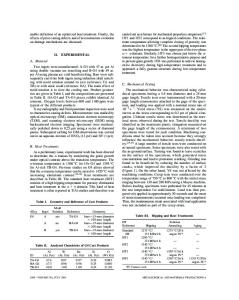Creep Mechanisms of Fully-Lamellar TiAl Based Upon Interface Sliding
- PDF / 2,757,441 Bytes
- 7 Pages / 412.74 x 641.7 pts Page_size
- 95 Downloads / 396 Views
INTRODUCTION Two-phase [TiAl (-y)-Ti 3A1 (a2)] TiAl alloys have recently attracted more attention than single-phase -y-TiAI alloys because of their superior combination of room-temperature mechanical properties. Great efforts have been made to improve the creep resistance of two-phase TiAl alloys through alloy design and microstructural optimization. By controlling thermomechanical treatments, three different types of microstructures [equiaxed, duplex, and fully lamellar (FL)] have been developed [1]. It is well known that the creep resistance of two-phase alloys with a FL microstructure is better than that of the alloys with equiaxed and/or duplex microstructures [1-4]. In addition, the creep resistance of powder metallurgy FL-TiAl alloys is superior to that of ingot metallurgy FL-TiAl alloys as a result of refined lamellar microstructures [2]. Although a remarkable progress has been made in improving the creep resistance of TiAl alloys, little is known about the underlying creep mechanisms. Many investigators have studied the creep behavior of FL-TiA1 alloys [3,5], only a few of the existing creep models have considered the contribution of interface sliding. It is worth noting that the motion of interfacial dislocations was recently demonstrated to play an important role in the creep deformation of FL-TiAI [6-8]. A previous investigation on the creep of refined FL-TiAI alloys has revealed that there existed two distinct creep regimes, i.e. low stress (LS) and high stress (HS), as shown in FIGOI [81. A nearly linear creep behavior was observed in the LS regime (< 400 MPa), i.e. ' - ot and n = 1.2 (1.6, and a nonlinear creep behavior with n = 6.7 - 10.1 in the HS regime (> 400 MPa.). The purpose of the present investigation is to correlate creep behavior with deformation (interfacial) substructure to elucidate further the creep mechanisms of refined FL-TiAl. EXPERIMENTAL A FL-TiA1 alloy with a nominal composition: Ti-47A1-2Cr-2Nb (in at. %) was used for this study. The alloy was fabricated by a hot-extrusion of gas-atomized titanium aluminide powder at 1400'C. The interstitial impurities [in parts per million (ppm) by weight] of the alloy are 0: 780; N: KK1.3.1 Mat. Res. Soc. Symp. Proc. Vol. 552 0 1999 Materials Research Society
40; C: 260. Test specimens with a gauge dimension of 24.4 x 5.08 x 1.52 mm were prepared from the annealed alloy by electrical discharge machining. Creep tests were conducted in a dead-load creep machine with a lever arm ratio of 16:1. Tests were performed in air in a split furnace with three zones at 760'C. Detail information regarding the creep experiment and experimental data was reported elsewhere [2,8]. For current study, the deformation substructures of two tested specimens [one crept at a stress of 138 MPa (creep strain: -0.25%) in the LS regime, and the other crept at a stress of 518 MPa (creep strain: -3.6%) in the HS regime] were investigated. TEM foils were prepared by twin-jet electropolishing in a solution of 60 vol. % methanol, 35 vol. % butyl alcohol and 5 vol. % perchlori
Data Loading...











